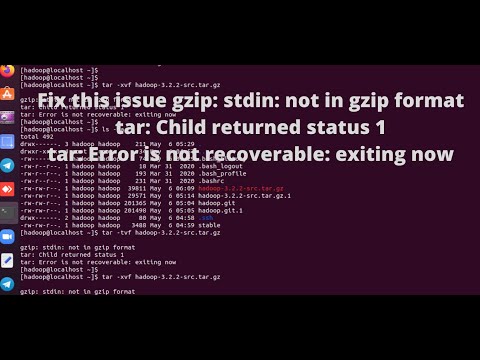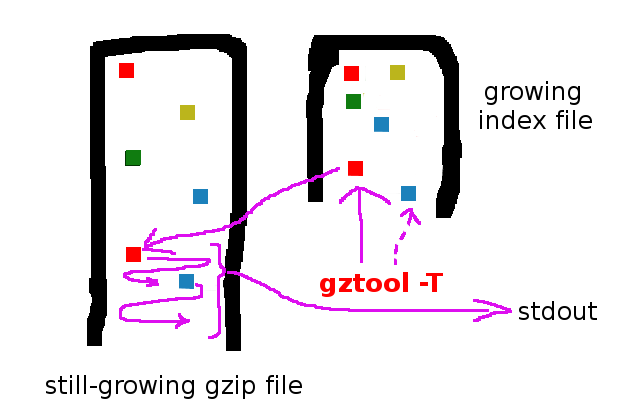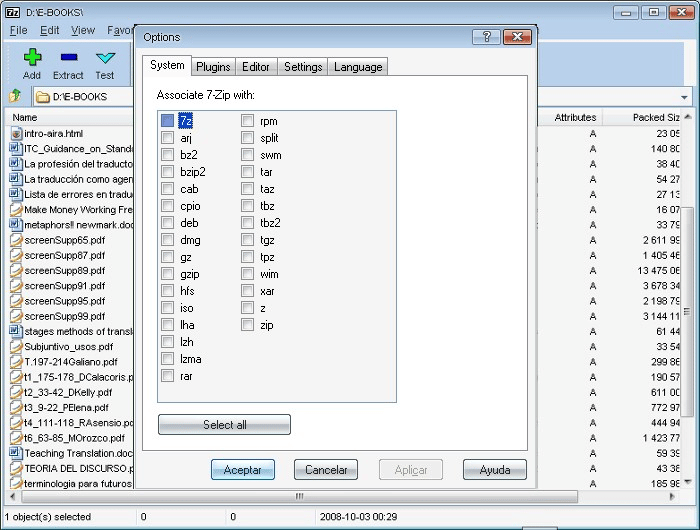Gzip: Stdin: Not In Gzip Format
Introduction
Gzip is a widely used file compression program that is used to reduce the file size without losing any data. It is most commonly used in UNIX-like operating systems, but it is also available for other platforms. Gzip uses a compression algorithm that significantly reduces the size of the file, making it easier and faster to transfer or store.
What is Gzip?
Gzip, short for GNU zip, is a file compression and decompression tool used in UNIX-like operating systems. It was developed as a replacement for the compress utility and is now a standard feature in most UNIX distributions. Gzip typically has a .gz file extension and can compress any file into a smaller size.
What is a .gzip format?
The .gzip format is simply another name for the .gz format, which is used by the Gzip utility. Both .gzip and .gz files are compressed files that can be created and extracted using Gzip. They have the same underlying format and can be used interchangeably.
Gzip: stdin: not in Gzip format – Causes of the Error
Encountering the error message “gzip: stdin: not in gzip format” indicates that the given file is not in the expected Gzip format. There are several potential causes for this error:
1. Incompatibility with Gzip format: The file may not be compatible with Gzip for compression or decompression. Gzip follows a specific format, and if the file does not conform to it, the error is thrown.
2. Incompatible file compression method: The file might have been compressed using a different compression method that Gzip cannot handle. Gzip is designed to work with its own compression algorithm and may not be able to decompress files compressed with other methods.
3. File corruption or incomplete download: If the file is corrupted or was not downloaded properly, it may result in the “not in gzip format” error. The error is triggered when Gzip attempts to read the file and encounters unexpected or missing data.
4. Incorrect file extension: The file may have the wrong file extension, leading Gzip to believe it is a Gzip-compressed file when it is not. Gzip relies on the file extension to determine the format, and if it is incorrect, the error is thrown.
Solutions to fix the “gzip: stdin: not in Gzip format” error
Now that we understand the possible causes of the “not in gzip format” error, let’s explore some solutions to resolve it:
1. Check file compatibility: Verify that the file is indeed compatible with Gzip compression. Ensure that it has not been compressed using a different compression method or is in a format that is not supported by Gzip.
2. Confirm file compression method: If you suspect that the file was compressed using a different method, try using the appropriate utility or application to extract it. For example, if the file is a .zip file, you can use a program like WinZip or 7-Zip to extract its contents.
3. Verify file integrity: Check for any signs of corruption or incomplete download. This can be done by comparing the file size with the expected size, performing a checksum, or attempting to download the file again from a reliable source.
4. Rename or convert file extension: If the file has the wrong file extension, simply renaming it to the correct extension (e.g., from .gzip to .gz) might resolve the error. Alternatively, you can try converting the file to the correct format using a file conversion tool or a dedicated compression utility.
Conclusion
Encountering the “gzip: stdin: not in gzip format” error can be frustrating, especially when you’re expecting a Gzip-compressed file. However, by understanding the potential causes and implementing the appropriate solutions, you can troubleshoot and resolve the issue effectively.
Additionally, it’s worth mentioning that similar error messages can occur with other compression utilities. Some examples include “tar: this does not look like a tar archive,” “tar: error is not recoverable: exiting now,” and “gzip rockyou.txt.gz not in gzip format.” The solutions provided in this article can also be applied to these error messages when encountered with corresponding compression utilities such as tar and Bzip2.
FAQs
Q: What should I do if I encounter the “tar: this does not look like a tar archive” error?
A: The error message suggests that the given file is not in the expected tar format. To resolve this issue, verify the file’s compatibility with tar, confirm the file compression method, check for file integrity, and ensure that the file has the correct file extension.
Q: How can I extract a .tgz file in Linux?
A: To extract a .tgz file in Linux, you can use the tar command with the appropriate options. For example, to extract the contents of a file named example.tgz, you can use the following command: “tar -xvzf example.tgz”. The -x option extracts the archive, -v displays additional information during extraction, and -z indicates that the file is compressed with gzip.
Q: Why am I getting the “Gzip: stdin: unexpected end of file” error?
A: This error indicates that the Gzip utility has encountered an unexpected end of file while attempting to decompress it. Possible causes include a corrupted or incomplete file, incorrect file extension, or compatibility issues. To resolve this error, check the file’s integrity, ensure it has the correct extension, and confirm its compatibility with Gzip.
Q: How can I extract a .tar.gz file in Linux?
A: To extract a .tar.gz file in Linux, you can use the tar command with the appropriate options. For example, to extract the contents of a file named example.tar.gz, you can use the following command: “tar -xvzf example.tar.gz”. The -x option extracts the archive, -v displays additional information during extraction, and -z indicates that the file is compressed with gzip.
Tar: Error Is Not Recoverable: Exiting Now
Keywords searched by users: gzip: stdin: not in gzip format tar: this does not look like a tar archive, tar: error is not recoverable: exiting now, Gzip rockyou txt gz not in gzip format, Gzip: stdin: unexpected end of file, Bzip2 10 6 tar gz not in gzip format, Tar gz file, Unzip tgz Linux, Tar gz Linux
Categories: Top 90 Gzip: Stdin: Not In Gzip Format
See more here: nhanvietluanvan.com
Tar: This Does Not Look Like A Tar Archive
## History of Tar Archives:
The origins of tar archives can be traced back to the early days of Unix development in the 1970s. The name “tar” stands for “tape archive,” highlighting its original intended use as a means of bundling files for storage on magnetic tapes. As Unix evolved and magnetic tapes became obsolete, tar archives transitioned to other storage devices such as hard disks, floppy disks, and eventually digital storage.
## Understanding Tar Archives:
A tar archive combines multiple files and directories into a single file, often ending with the extension “.tar”. It is crucial to note that a tar archive does not compress its contents by default. Instead, it serves as a container for file organization and backup purposes. To compress a tar archive, it can be further processed using tools like gzip or bzip2, resulting in file extensions such as “.tar.gz” or “.tar.bz2”.
## Applications of Tar Archives:
1. **Backup and Restore**: Tar archives are commonly used to create backups of files and directories. By bundling multiple files into a single archive, it simplifies the process of transferring and restoring data, especially when dealing with large volumes.
2. **Software Distribution**: Many applications and software packages use tar archives as a means of distributing their contents. This allows developers to package multiple files together, including source code, documentation, and configuration files, simplifying the installation process for end-users.
3. **System Administration**: Tar archives play a significant role in system administration tasks. System administrators often employ tar archives to bundle configuration files, scripts, and other relevant data to ensure the portability and easy restoration of system settings.
4. **Archiving and Compression**: Although tar archives do not inherently compress their contents, they can be processed by compression tools like gzip or bzip2 to reduce the overall size. Compressed tar archives are frequently utilized for long-term storage or sharing files over networks, as they consume less disk space and reduce transfer times.
## Benefits of Tar Archives:
1. **File Organization**: Tar archives simplify file management by allowing multiple files and directories to be bundled together in a single container. This aids in keeping related files organized, improving efficiency and accessibility.
2. **Preservation of Permission and Ownership**: Tar archives preserve file permissions and ownership information, ensuring that these attributes are maintained during backup and restoration processes. This is particularly valuable in preserving the integrity and security of the stored data.
3. **Faster Transfer Speeds**: Compared to transferring individual files, tar archives expedite the transfer process by packaging multiple items together. This reduces the number of file operations required during transfers and saves valuable time, especially for large file sets.
4. **Easier Restoration**: When restoring data, tar archives provide a straightforward approach. A single tar archive can be extracted, preserving the directory structure and ownership information, making the process more efficient and error-free.
## FAQs about Tar Archives:
**Q: Can tar archives only be created and extracted in Unix-based systems?**
A: While tar archives originated in Unix systems, they can be created and extracted in various operating systems, including Linux, macOS, and even Windows using third-party tools.
**Q: What are the different compression methods used with tar archives?**
A: The most common compression methods for tar archives are gzip and bzip2. These tools apply different compression algorithms to significantly reduce the size of the tar archive.
**Q: Are tar archives encrypted by default?**
A: No, tar archives do not provide encryption by default. If encryption is required, it needs to be implemented separately, either before archiving or after extraction.
**Q: Can I add or remove files from an existing tar archive?**
A: Yes, files can be added or removed from an existing tar archive using appropriate tar commands. However, it is generally recommended to create a new archive to avoid potential data corruption.
**Q: How do I extract a specific file or directory from a tar archive?**
A: To extract a specific file or directory from a tar archive, you can use the tar command with the appropriate options and specify the desired file or directory name.
In conclusion, tar archives have played a crucial role in Unix and Unix-like systems for preserving file organization, simplifying data backups, and facilitating software distribution. Their ability to bundle multiple files and directories together, coupled with compressing capabilities, makes tar archives a versatile tool in various contexts. With their long-standing history and continued relevance, tar archives remain a fundamental component of data management and system administration.
Tar: Error Is Not Recoverable: Exiting Now
Introduction:
Tar (short for Tape Archive) is a widely used command-line utility in Unix systems for archiving multiple files into a single file. It is a powerful tool that packs files together, making them easier to manage and distribute. However, like any software, tar is not immune to errors, one of which is “Tar: Error is not recoverable: Exiting now.” In this article, we will delve into the possible causes, troubleshooting methods, and frequently asked questions (FAQs) related to this error.
Common Causes of the Tar Error:
1. Insufficient Permissions:
– The most common reason for encountering the “Error is not recoverable: Exiting now” message is inadequate permissions. If the user executing the tar command does not have sufficient rights, it cannot access or write the specified files or directories. This results in an error and termination of the tar process.
2. Disk Space Limitations:
– Another possible cause relates to the amount of available disk space. Tar requires enough free space to store the resulting archive file. If the target drive runs out of space during the compression process, an error is likely to occur.
3. Unsupported File Types or Corruption:
– Tar can encounter problems when trying to archive specific file types or files that are corrupted. Unusual characters or file extensions can sometimes confuse tar, leading to unexpected errors.
4. Long Path or File Names:
– Tar may fail if the path or file names are excessively long. The maximum length for path + filename usually varies based on the filesystem used, and exceeding this limit can trigger an error.
Troubleshooting the Tar Error:
1. Check Permissions:
– Ensure that you have appropriate permissions to access and modify the files/directories you are trying to archive. Use the “ls -l” command to view the permissions, and if necessary, change them using chmod.
2. Verify Available Disk Space:
– Prior to executing the tar command, check the available free space on the destination drive using the “df” command. If space is limited, consider deleting unnecessary files or allocating more space before attempting the tar operation again.
3. Validate File Integrity:
– Examine the files you are attempting to archive for any corruption. Run a file system check using “fsck” or ensure that the files are not encrypted, damaged, or partly extracted by any other tool.
4. Shorten File Paths or Names:
– If the file paths or names are excessively long, try renaming them to reduce the character count. Move the files closer to the root directory or use symbolic links to make it easier for tar.
Frequently Asked Questions (FAQs):
Q1. Can tar be used in combination with compression tools?
Yes, tar can be combined with other compression tools such as gzip or bzip2 to create compressed archives. For example, the command “tar -zcvf archive.tar.gz files/” will create a compressed tar archive using gzip.
Q2. How to extract specific files from a tar archive?
To extract specific files from a tar archive, you can use the “tar -xvf archive.tar” command followed by the file name(s) or path(s) you want to extract. For instance, “tar -xvf archive.tar file1.txt file2.txt” will extract only file1.txt and file2.txt.
Q3. Is tar limited to Unix-like systems only?
Although tar is commonly associated with Unix-like systems, it is not exclusive to them. Tar utilities are also available for Windows, macOS, and other operating systems. However, note that the command-line syntax may differ slightly between platforms.
Q4. How can I exclude certain files or directories from a tar archive?
To exclude specific files or directories while creating a tar archive, you can use the “–exclude” flag followed by the file(s) or directory name(s) to be omitted. For example, “tar -cvf archive.tar –exclude=folder/exclude_me file.txt” will exclude the “exclude_me” folder and “file.txt” from the archive.
Q5. Are there GUI tools available for working with tar archives?
Yes, several graphical user interface (GUI) tools are available that provide a more user-friendly experience for managing tar archives. Examples include “Ark” for KDE, “File Roller” for GNOME, and “7-Zip” for Windows, all of which support creating, extracting, and manipulating tar archives.
Conclusion:
Tar is a versatile archiving tool that aids in bundling files for ease of management and distribution. However, encountering the “Tar: Error is not recoverable: Exiting now” message can be frustrating. By understanding the common causes and troubleshooting methods discussed above, you can overcome these errors and fully utilize the potential of tar. Remember to ensure proper permissions, sufficient disk space, file integrity, and handle long path or file names diligently to avoid such issues.
Gzip Rockyou Txt Gz Not In Gzip Format
——————————————-
Introduction:
——————
Gzip, short for GNU zip, is a popular file compression algorithm widely used to reduce the size of files for storage or transmission purposes. However, encountering a file named “rockyou.txt.gz” that is not actually in gzip format can be puzzling. In this article, we will delve into the intricacies of this phenomenon, exploring what it means when a file claims to be compressed with Gzip but fails to adhere to its format.
Understanding Gzip and Its Format:
————————————–
Gzip is a lossless compression algorithm commonly employed to reduce the size of various types of files, including text documents, log files, and program executables. It uses a combination of the Deflate algorithm and a LZ77 sliding window compression technique to compress the data.
The Gzip format typically consists of a header block, followed by one or more compressed data blocks, and ends with an end-of-archive marker. The header block provides essential information about the compressed file, such as the compression method used, the original file name, and file modification timestamps.
The file extension “.gz” usually signifies that the file has been compressed using Gzip. However, it is important to note that the presence of “.gz” in the file name does not automatically guarantee that the file is correctly formatted.
The Pseudo Gzip Format:
—————————-
In the case of a “rockyou.txt.gz” file not being in Gzip format, it is often referred to as a pseudo Gzip format. This occurs when the file extension suggests that it should be recognized as a valid Gzip file, but the actual structure of the file does not conform to the expected Gzip format.
Possible Explanations for Pseudo Gzip Format:
—————————————————-
1. Corrupted File: One possibility is that the file was corrupted during transmission or storage. If the file was suddenly interrupted or improperly transferred, it might lose its Gzip format integrity, rendering it unusable by Gzip programs.
2. File Misnaming: Another common explanation is that the file was mistakenly named with a “.gz” extension despite not being in Gzip format. This could be a simple human error, or it might have been caused by an automated process that misinterpreted the file’s actual format.
3. Data Conversion Issues: When dealing with file conversions or data manipulation, it is possible that a misunderstanding of the Gzip format led to the inappropriate naming or formatting of the file. Certain operations, such as extracting only a part of a Gzip file and then re-saving it, can result in an invalid pseudo Gzip format.
4. Malware or Security Measures: In rare cases, finding a “rockyou.txt.gz” file not in Gzip format might be the result of intentional action. Malware or security measures utilized by certain systems or programs can sometimes modify files’ formats, potentially renaming them with misleading extensions.
FAQs (Frequently Asked Questions):
————————————–
Q1. How can I identify if a file claiming to be in Gzip format is valid or not?
A. One way is to check the file’s structure by using commands like “file” or “binwalk” in a terminal. These utilities analyze the internal signatures and search for indications of a valid Gzip file. Alternatively, you can try decompressing the file using Gzip tools. If the decompression fails, it is likely not in Gzip format.
Q2. Can I convert a pseudo Gzip file back into a valid Gzip file?
A. In most cases, it is not possible to convert a pseudo Gzip file into a valid one. The file’s original format might have been irreversibly altered, making it incompatible with Gzip decompression. However, you can attempt hypothesis testing by analyzing the file’s data and attempting manual recovery.
Q3. Are there any risks associated with opening or attempting to decompress a pseudo Gzip file?
A. While the majority of pseudo Gzip files are harmless, it is not advisable to attempt to decompress or open files obtained from untrusted sources. There is a slight risk associated with executing files containing malicious payloads or vulnerabilities. It is crucial to exercise caution and, if uncertain, seek expert assistance.
Q4. What should I do if I encounter a file that claims to be Gzip but is not in Gzip format?
A. If you encounter a pseudo Gzip file, your best course of action is to verify the file’s integrity, ensure your system is secure, and seek professional assistance if required. Renaming the file or attempting to open it without expert guidance may lead to unintended consequences.
Conclusion:
—————-
Encountering a file named “rockyou.txt.gz” that is not in Gzip format can raise questions and confusion. In this article, we demystified the phenomenon of pseudo Gzip files and explored potential explanations for their existence, such as file corruption, misnaming, data conversion issues, or security measures. Understanding the implications of pseudo Gzip format enables us to better assess the files we encounter and make informed decisions about their handling. Remember, always exercise caution and seek professional expertise if unsure about a file’s validity or integrity.
Images related to the topic gzip: stdin: not in gzip format

Found 30 images related to gzip: stdin: not in gzip format theme

















Article link: gzip: stdin: not in gzip format.
Learn more about the topic gzip: stdin: not in gzip format.
- How to solve gzip: stdin: not in gzip format error – Linux Hint
- stdin: not in gzip format tar: Child returned status 1 tar: Error is …
- How to solve: stdin: not in gzip format – It’s FOSS
- How to Solve gzip: stdin: Not in gzip Format Error
- [SOLVED] gzip: stdin: not in gzip format – LinuxForDevices
- downloads – gzip: stdin: not in gzip format – Ask Ubuntu
- How to Fix gzip stdin not in gzip format – – TechColleague
- How to Fix Stdin: Not in GZIP Format – Fedingo
- stdin: not in gzip format – Discussion – BMC Community
- Issue with installing golang on wsl2 – (gzip: stdin – GitHub
See more: nhanvietluanvan.com/luat-hoc